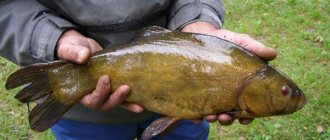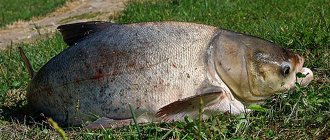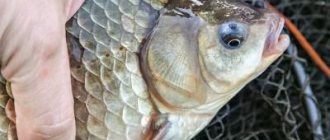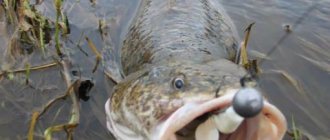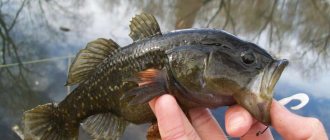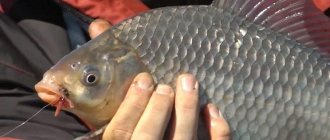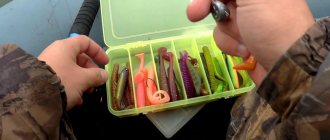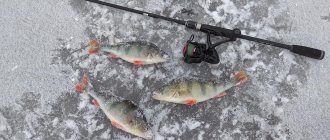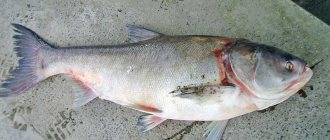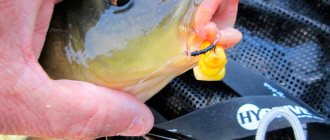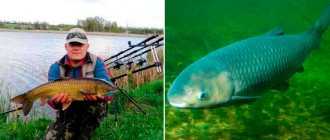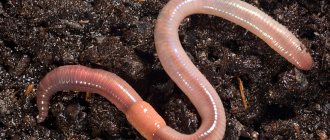Description and behavior characteristics
Tench belongs to the carp family; it is sedentary and calm. Undemanding to water quality, tolerates lack of oxygen well. It does not like bright light, and therefore prefers to stay near the very bottom. The body of the tench is multi-colored, the back is green-yellow, and the barrel is olive.
The scales are small, covered with viscous mucus on top. The fins are dark purple, rounded, and the eyes are small, bright red. It feeds mainly on green reeds, reeds, duckweed, and finds food in the bottom silt. It also eagerly eats: aquatic insects, worms, leeches, larvae, mollusks, crustaceans, and fry.
In summer it feeds only at dusk and at night.
Average weight from 300 gr. up to 2 kg, but there are also 7 kg individuals. When the water warms up to 14° C, spawning begins, somewhere from May to July, it does not migrate. It accumulates in small groups only in wintering areas or during the spawning period.
When the reservoir freezes and the summer drought occurs, the tench buries itself in the silt and falls into a long-term torpor. It can only be detected by air bubbles on the surface of the water, at dawn or in the evening. With the onset of persistent frosts, they stop feeding and freeze in mud pits until it warms up. It is preferable to hunt for it in the warm season; at other times there will be no bite.
Habitats
Inhabits: Eurasia, lakes and rivers of the Baltic, Black, Caspian and Azov seas. Found in the Baikal basin, in its western part. In the upper reaches of the Yenisei and Ob. Lives: lakes, ponds, river bays, channels, reservoirs, etc.
It prefers a silt-clay bottom, and an abundance of underwater and aquatic vegetation: water lilies, duckweed, egg capsule, reeds, pondweed, reeds, cattails, etc. It prefers reservoirs with standing water or weak currents.
Tench never changes its habitat , but has its own areas known only to it, to which it always returns. An observant fisherman can detect it: by the swaying of the stems on the water, air bubbles, cloudiness of the water, etc.
Peculiarities of tench biting by season
- Winter. In winter, she does not feed, but is in deep hibernation. Therefore, it is not possible to catch it at this time.
- Spring . With the arrival of spring, he will come to life and, when hungry, will rush to any food offered to him. But a particularly favorite delicacy for him: bloodworms, bell larvae, and red worms. By mid-May, the bite will subside, and then stop completely before spawning. It will resume in 2 weeks because summer is starting.
- Summer. A favorite time for fishermen, because the catches are stable and it’s warm. On particularly hot days, the bite will only be after sunrise, or late in the evening. But only night fishing can be especially catchy. For bait, various baits are used: vegetable, animal. Which ones exactly will depend on the taste preferences of aquatic inhabitants.
- Autumn. You can fish throughout the entire fall with varying success, right up until the leaves fall. A good bite occurs in cloudy but warm weather with drizzling rain. But when incessant rains begin, not even the most attractive bait will be able to lure the tench out of the depths. At the beginning of autumn it is better to use plant baits, but in October switch to animals: bloodworms, worms, slugs, snails, maggots, etc.
Selection of baits depending on the season
Seasonal characteristics of tench should be taken into account when choosing bait:
- spring. You will have to determine whether tench bite in April in your region experimentally, using animal bait. If the period when tench bite in the spring falls in April (typical for an average climate), it is better to use all kinds of insects, snails, worms and leeches. After a series of unsuccessful fishing trips, the angler has a question about what tench bites in May, it’s all about including plant foods in the diet;
- summer. It’s easy to find out what tench bite on in the summer, just by taking with you several different baits: peas, dough, potatoes, worms, leeches. Sometimes prey bites exclusively on plant baits. In reservoirs crowded by fishermen, tench tend to feed on only one bait and may not respond to others at all;
- autumn. As it gets colder, the fish go to a depth of about 3-4 m. There are practically no temperature fluctuations in the water column. Now fishing is less effective, but still possible using leeches, worms, maggots and various artificial baits with flavors. The bite is more likely to be successful during warmer weather. It is impossible to catch the desired prey when the temperature drops to 10°C or on days with strong winds;
- winter. In winter, the tench sleeps; the only chance to catch it is to wait for a thaw. In warm winters, fishing is possible with autumn baits; bloodworms are best.
Read more
How to catch pike perch in winter using hooks?
Catching tench in the spring with a float rod is the most promising and easiest way of fishing.
Tench fishing methods
There are many ways to catch this difficult fish, but the two most popular are: a float rod and a feeder tackle. You can fish from a boat or shore, but it is more comfortable from a boat. And it will be easier to change the place if necessary.
Float rod
Fly tackle
It is necessary to choose a place for future fishing, and based on the characteristics of the reservoir, we begin to equip the fishing rod. For fishing from a boat, from the shore, in an overgrown reservoir, use fly tackle :
- rod—4–7 m;
- high-quality monofilament line - 5.5–6.5 m, Ø 0.21–0.30 mm;
- hook - N°7–10;
- float load capacity - 2–2.5 g;
- subpastor - 0.5 g;
- nylon leash - Ø 0.16–0.20;
- 2-3 pellets - 1 g each.
Match equipment
A match fishing rod is used in unpolluted reservoirs, its equipment:
- rod with rings - 3.4–4.5 m;
- spinning reel - 2000–3000;
- monofilament - Ø 0.20–0.27 mm;
- hook - N°6–10;
- sliding olive, made of lead -2–4 g;
- fluorocarbon leash - Ø 0.13–0.18 mm, length 20–30 cm;
- subpastor - 0.5 g;
- float of bright colors - 4–5 g.
Feeder tackle
It is assembled from the following components: feeder, rod, fishing line, reel and leash with hook. The set always begins with choosing a feeder.
It is better to acquire several models at once, of different weights and sizes:
- For the current you will need weighted ones, preferably triangular or square in shape. To cast the equipment 60–80 m, you will need 80–100 g of feeder.
- Without current - light, round or oval, for distant casting you will need a 60-80 g structure.
The rod is selected for fishing conditions, the test load should be in the following range: the total weight of the feeder plus bait should not exceed the upper permissible threshold, if the weight of the feeder is 40–50 g, plus 20–30 g of bait, then the test is in the range of 50–110 G.
We select the length based on the casting distance and the activity of the water flow:
- calm waters - 3.3 m;
- leisurely waters - 3.6–4 m.
Equipment:
- reel 3000, gear ratio 1:5, 1:6;
- fishing line (braid) Ø 0.13 mm;
- leash - a piece of monofilament Ø 0.19 mm;
- hooks - No. 5-6 for small bait for grains, etc., and No. 7-10 for larger bait: maggots, worms, worms, corn, etc.
To make the feeder equipment more sensitive, it is necessary to combine the feeder with the main fishing line. This can be done in different ways: anti-twist tube, Gardner equipment, loop equipment, etc.
Baits and lures
Baits and lures are used to attract fish to the hook. This can be food: animal, plant origin, or imitation food.
The choice will depend on:
- features of the reservoir;
- season;
- fishing place;
- type of fish;
- depths;
- indicators of atmospheric pressure, etc.
The main condition is that the bait should look tempting, and the tench should not notice any catch. Now let's take a closer look.
Animal origin
When choosing, take into account the tastes of the fish, and it prefers animal bait most of all. Those that can be found during this period of time are especially valuable. In summer, for example, worms will be very good, just drip them near the river. It can be extremely difficult to please this fish; you only need to adhere to the naturalness of the diet:
- Various worms (earthworms, dung worms, etc.) are best, especially in a bunch of 2-4 pieces, the hook point should be completely covered.
- Maggots are small, grown on vegetables or meat. 1–7 pieces are pinned onto the hook at once, depending on the fishing method. The sting should not protrude too much, otherwise the tench may refuse the treat after being pricked.
- Shitik - if there are flowing streams, then there are shitiks. Put on 1-3 pieces so that the sting is not visible. His only drawback is his quickly deteriorating body, and the other fish lads adore him, so they quickly eat him up.
Bark beetle larva
Muckworm
Maggots (attachment options)
Dragonfly larva Ant eggs
Shell meat - In the green reeds there lives a green soft larva , reaching up to 4–5 cm; moults simply adore it.
- The larva of a dragonfly - but only a large tench can encroach on it. They are inserted between the skull-shaped jaws, and the sting is brought out from the bottom of the abdomen. It should not stick out much, but when touched, it should be slightly felt with your finger.
- Shellfish meat (shells, pond snails, pearl barley, etc.) - is caught in places where mollusks accumulate, the hook tip must be completely drowned in the fleshy part.
- Larvae of bark beetles - in fallen trees flooded by spring waters, beetles lay larvae, which are an excellent bait. They string 2–4 pieces, the sting is masked.
- Ant eggs - put on 5-7 eggs, pressing down the sting.
- «Sandwiches» - combinations of attachments:
- bloodworm - mollusk;
- maggot – worm;
- shitik - ant eggs, etc.
Curd bait
If you have cottage cheese in the refrigerator, then prepare a cottage cheese bait:
- missing cottage cheese 300 gr.;
- sunflower cake 600 gr.;
- breadcrumbs 500 gr.;
- a handful of peat;
- flavorings (any of your choice).
Mix all the ingredients well, then form small balls.
Plant-based: recipes
1 recipe:
- canned corn – 0.5 cans;
- breadcrumbs – 1–1.5 kg;
- hemp seeds – 200 gr.;
- cocoa powder – 40 gr.;
- sugar – 3 tbsp. l.;
Mix the dry ingredients, then the rest, bring to the desired consistency with water.
Recipe 2:
- semolina – 0.5 kg;
- corn grits – 0.5 kg;
- cake – 0.5 kg;
- oat flakes – 0.5 kg.
Mix and let it brew for half an hour; upon arrival, add a little water from the reservoir.
Recipe 3:
- pearl barley;
- peas;
- millet;
- some homemade butter;
- 1 tbsp. l. honey.
Cook porridge from cereals, the main thing is to make sure it doesn’t burn, then add butter and honey.
How to choose bait depending on the place where tench is caught
It is impossible to say exactly where to catch tench, since the fish is unpredictable and is periodically found in the most unexpected places. Where tench bite, prey preferences may differ depending on the bottom topography and surrounding flora.
What to consider when preparing mixtures:
- in small pits with thickets of reeds, water lilies, etc., tench tend to feed more actively. In such places, almost any bait is suitable as bait: the usual worms, bloodworms and maggots, as well as mussels, snails, and shrimp. It is important to take into account the caution of the fish; from a depth of less than two meters, tench are able to see the fisherman and stop feeding. When going for tench, we recommend maintaining silence; sounds alert the prey;
- at great depths, prey feeds exclusively on bottom food, including maggots and worms. There is no point in casting snails and shrimp; they will come off the hook during casting.
It is easier to catch fish in cool weather with little wind; in calm weather it has good visibility, and the likelihood of being detected by a fisherman is high. We recommend choosing fishing spots with an abundance of vegetation; this is the most promising fishing spot. Knowing when tench bite in the spring in the middle zone (from mid-April), it is important to determine the type of bait that is effective during this period. The taste preferences of fish change with the season.
When preparing mixtures, the composition must be taken into account depending on the fishing season.
Nuances of bait
In order for the tench to peck well, you need to feed the same place for several days. Only in small water areas, this fish can bite after the first bait. Much will depend on the time of year, day, and weather conditions. Shallow water areas, at the edge of reed thickets, in a “window”, etc., are most suitable for feeding.
You cannot feed with heavy balls, because the bottom is usually covered with a layer of silt or greenery, and when they sink into them, they become invisible. It is more advisable to prepare a loose mixture from crushed components, but it should consist of large fractions. Its slow immersion promotes attachment, and the fry will not be able to eat it.
It is better to introduce a little, but with nutritious bait, than a lot, but “empty”. Only targeted feeding can give the best results. It is advisable to enrich plant baits with a “meat” additive: maggots, worms, crawlers, pupae, etc.
Places of attachment must be inspected regularly. Approach the shore or swim up on a boat and see whether the bait has disappeared or not. If it is shallow and the water is clear, it will be clearly visible. If the water is deep and opaque, then only by the characteristic air bubbles can one find out whether the tench is feeding or not.
With your own hands
Recipe No. 1:
- any bran 1 kg;
- boiled semolina, a little;
- boiled or steamed millet 0.5 kg;
- a handful of chopped worms.
Recipe No. 2:
- sunflower cake;
- breadcrumbs;
- hemp oil 2-3 drops;
- grains, any (steamed).
Mix everything in equal proportions and leave for 1-2 hours.
Recipe No. 3:
- fry rolled oats;
- boiled potatoes;
- White bread;
- peas (steamed).
The proportions are arbitrary, soak the bread and mix with all the ingredients.
Shop
In fishing stores you can always buy ready-made baits suitable for all types of fishing.
If you don’t find a molt, use another: carp, crucian carp. The main thing is that the bait is suitable for standing water; read the information on the pack.
A spring or method feeder is often depicted on the packs. You need to choose only dark baits so that they blend in with the muddy bottom. Contains: rich in proteins and betaine, and many other nutrients.
How to catch tench?
To catch a tench, you must think like a tench:
- Look for thickets of underwater vegetation. Egg capsules, water lilies, reeds, cattails, and horsetail are tench’s favorite habitats. No one argues that it can be found on a bottom free of plants, but we want to increase the chances of catching it! This means we throw our gear at the border of aquatic vegetation with clean water, and it’s even better to fish in the windows between such plants. If there are no such windows or they are very small, then you can make them yourself. A rake will help you. But it is better to carry out this procedure in advance, do not forget that tench is a rather shy fish!
- Forget about long casts. Tench feed at a depth of 0.5 to 1.5 meters. Collects larvae of aquatic insects, worms, snails, leeches. All these living creatures live near the shore and attract molts here. So why would we deliberately throw our gear into the distance, to where our fishing object appears much less often? There are reservoirs where the casting distance does not make a fundamental difference, but this is rather an exception to the rule. In practice, most often a regular fly rod 4-6 meters long is enough to show good results.
Catching a tench is real happiness!
- Keep quiet. Since we are fishing for tench close to the shore and counting on decent specimens, we need to remember the timidity of this fish! Tench live alone or in very small flocks. Therefore, the noise created during fishing will not cause us any particular harm, however, in order for this very fishing to take place, we need to sit quietly and not make noise. After catching the next tench, it’s time to do additional feeding, since we’ve already made a splash, we have nothing to lose, we throw bait balls at the fishing point.
- Look for linear paths. A chain of bubbles rising from the bottom and moving plants give away its presence. Often he follows the same proven path. Find this place and slip the hook with the nozzle under his nose!
- Don't skimp on the bait. Lin is very gluttonous. In this he is very similar to his brother carp. You can be a hundred times observant and accurately calculate the linear path, and then sit and wait for him to swim along it again, hoping that the green-sided underwater “piglet” will appreciate and swallow the bait. To increase your chances of catching a tench, hold it in this place. Get him interested. Bait for tench is like a magnet. Also, with the help of bait, you can “call” tench out of the thickets to the border of clean water, where fishing is much more comfortable. True, it’s still unlikely to lure them away from vegetation.
- Train your tench to eat in the same place! The bait is a powerful weapon when catching any fish. Tench is no exception. It’s good if it is possible to bring food in the same place every day, and better yet, at the same time. This will enliven the subsequent fishing process, and the likelihood of catching a large specimen from a given point increases significantly!
- Use durable, but not rough, tackle. Lin tastes the “treat” offered to him for a long time before swallowing it. A massive hook, a heavy sinker, a short thick leader, a bright large float at a shallow depth - all this is very suspicious for shy fish. Modern fishing lines have high strength even with small diameters. Choose a strong rod so that you can prevent powerful fish from hiding in nearby plants after hooking, which almost always means a cliff. The right equipment is half the success!
- Be patient and don't fuss! Tench is a leisurely fish, so don’t rush! Be prepared for the fact that even with a good bite you won’t be able to catch many tench. Until one fish comes up, until it decides to attack the vole, until after noisy fishing the next one decides to approach. Feel the atmosphere of fishing, not fish storage! Enjoy the process, and the result will be the icing on the cake!
Tench fishing techniques and tactics
- To begin with, it is advisable to locate the place of fatting; if clusters of small bubbles appear on the surface of the water, it means that tench has arrived.
- Its location can also be determined by ear; when it licks larvae from algae, a characteristic smacking sound is heard.
- The most popular baits: crawlers, shell meat, worms, maggots, bloodworms, chafer larvae. Vegetable: peas, semolina porridge, corn. Don't forget the bait: chopped worms, shell meat, crackers or bran.
- You can’t talk loudly on the shore, stomp, cast a shadow on the water, or noisily struggle with hooks.
- The bite can sometimes last up to 10 minutes. At first, the float simply twitches and it seems that it is about to go under water. But this doesn’t happen, he just tries it out. Then everything calms down, and after 30–40 seconds it repeats again, and so on several times in a row. When the tench finally decides to grab the bait, you need not to yawn and make a sharp hook.
- If hunting is carried out from the shore, clear a path in the seaweed for fishing in advance.
Tips and tricks
Basic recommendations and useful tips:
- If there is no bite for a long time, try an effective remedy : cut out a small piece of grass along with the turf, put 3-4 worms or maggots there, wait until they dig in there and use the bait for its intended purpose.
- To prevent maggots from turning into pupae in hot weather , wrap the container with wet rags.
- If you plan to fish on a sticky, swampy bottom , where the hook and bait can be immediately absorbed by quagmire or silt, we recommend attaching a small piece of foam plastic painted in any dark color 3–5 cm from the hook.
- At first, you can feed in large portions so as not to make any more noise.
- Tench never stay in one place for a long time; even a small pressure drop or a change in wind leads to the cessation of fishing, even in a place that has been fed for a long time.
Description of the tench
According to Leonid Pavlovich Sabaneev (1844-1908), true golden tench (var chrysitis) was not found in Russia, was rare everywhere and was found only in Bohemia and Silesia. Record fish of the nineteenth century reached a weight of eighteen and a half pounds (7.4 kg). But even in our time, in the eriks of the Kuban, according to local fishermen, tench up to seven kilograms can be found.
This red-eyed, sleepy fish loves the quiet waters of grassy river bays, oxbow lakes, and lakes overgrown with water lilies and reeds.
Lin is a loner. It avoids its fellows, and tench can be found in large numbers only during the spawning period. But I happened to get caught by an active tench bite. At the end of August, at one of the village ponds, these leisurely fish were biting quite confidently and often. On the same pond, the axiom about the tench’s indispensable love for the soft muddy bottom suffered somewhat. The fish were caught on the sand, barely covered with silt, behind a strip of viscous mud. However, there is an analogy with bait fishing. Since tench does not particularly like vegetable and flour baits, it is lured (immediately before fishing) or baited (for a long time before fishing) usually with chopped worms, since whole worms will immediately burrow into the ground. The halves will also bury if the soil is very soft. In addition, in the mud and grass, infantile fish simply will not see the bait. Therefore, experienced shedders mow plots among the grass into which they pour a sufficient amount of sand. On such an improvised table, the bait remains for a long time until it is eaten, and the bait is clearly visible. True, at the present time, it seems that no one practices this method of fishing. And there are not many fans of this slow-water fishing now.
But I once saw true lovers of catching golden tench. At one time, two grumpy old men settled on the lake of my childhood. As a boy I met them here. They knew how to catch large tench with a fishing rod, which were very rarely hooked by other fishermen. And the old people had their own rafts, light ones, with a “seat”, an oar and a pole. They went out on their rafts to important line places. They stood in the grass, to the windows among the water lilies, where sand was poured onto the cleared bottom. It is from these spots in the grass that the red-eyed sleepy tench is accustomed to taking the bait. The old people quietly whiled away their days on the lake, and just as quietly, unnoticed, they left it. Apparently their time has come...
Another period when there can be quite a lot of tench in one place is late autumn. Gathering in flocks, they go into the depths and lie down for the winter. In smaller or smaller places, like crucian carp, they can bury themselves in the mud and remain in suspended animation.
After hibernation, in early spring, tench begin to feed greedily. At this time, contrary to the popular belief that it can only be caught with a float rod, I had to catch tench even with throws.
